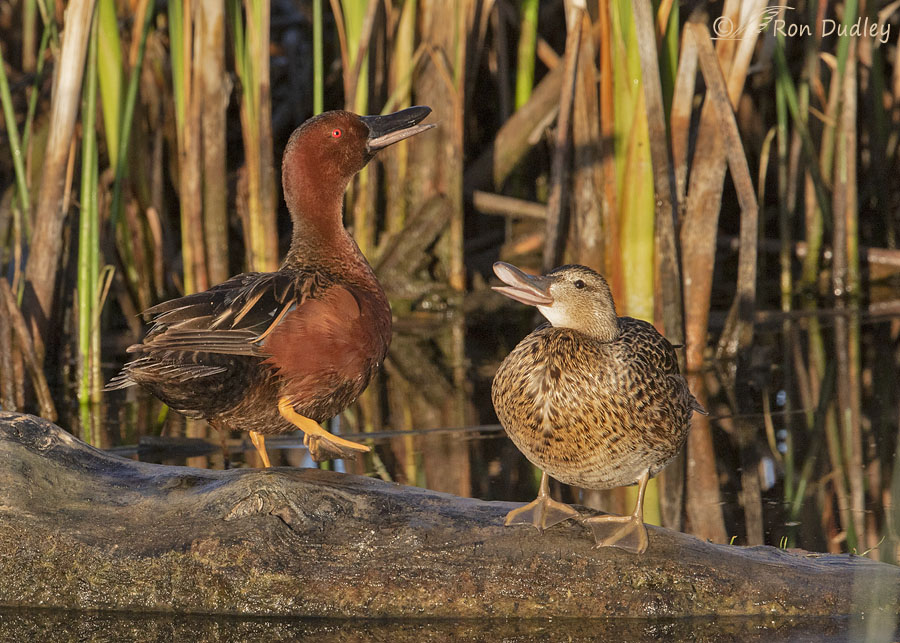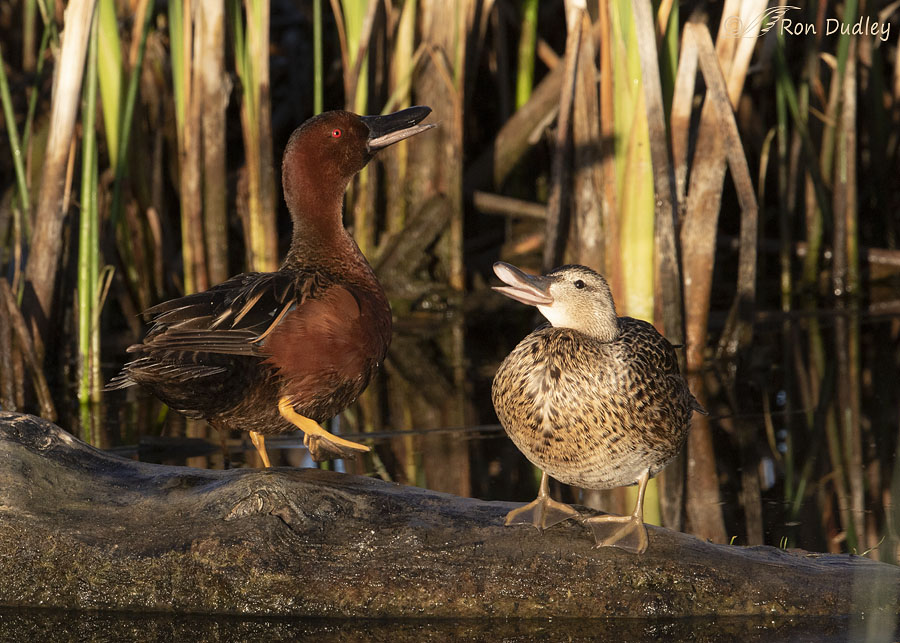I took a huge chance and used the dreaded Shadows/Highlights tool in Photoshop on this image in an effort to save it.

1/640, f/11, ISO 800, Canon 7D Mark II, Canon EF 500mm f/4L IS II USM + EF 1.4 III Extender, not baited, set up or called in
Eight days ago I took quite a few photos of this mated pair of Cinnamon Teals at Bear River MBR. Cinnamon Teals are one of the least common dabbling ducks in North America so I’m always delighted when they return for breeding season and we have them in good numbers. These two ducks appeared to be “talking” to each other and for me that’s the primary appeal of the image, especially given the animated foot action of the male for emphasis.
The light was low and the two ducks were on different planes relative to me so it was a challenge to have enough depth of field to get them both sharp. F/11 gave me sufficient DOF but it sure slowed my shutter speed. But the biggest problem I had was the lighting. The lighter female was brightly lit but light was hitting the darker male at a more oblique angle so he was much darker and I didn’t like the disparity. I tried to mitigate the problem as best I could in Adobe ACR during RAW conversion by adjusting highlights and shadows but I didn’t like the results.
So for this version I used the dreaded Shadows/Highlights tool in Photoshop on the jpeg. I say “dreaded” because that tool is notorious for causing processing artifacts such as sharpening halos so I almost never use it but I thought this image had enough potential to take the chance. The result is the version of the photo you see above and thankfully I’m not seeing a sharpening halo although I think it does have a bit of an “over-processed” look.
But I still like it better than the original. Maybe…

This is what I started out with. All I’ve done to this version is globally sharpen the image. For my tastes the female is just too bright and the male too dark.
Any thoughts? Should I have left “well enough” alone or is the Shadows/Highlights version an improvement, despite what I perceive to be a bit of an over-processed look?
Sometimes photographers try too hard to save an image that is unsalvageable and I hate being guilty of that more than I hate losing the image.
Ron
PS – I want to make it clear that I don’t really believe these two ducks were talking to each other. During breeding season especially Cinnamon Teals commonly perform head-pumping in the presence of other males and there was another mated pair of teals not too far out of frame to the left. These ducks were head-pumping and I just happened to catch both of their bills open with the male’s foot raised.
But who knows, maybe they were doing both…


Yet another great image. … I think the best justification I have for any moderate post processing is does the modified image ‘look’ closer to what I actually saw with my own eyes. The digital sensor’s determination is mechanical and varies sensor to sensor, so what comes out is by definition artificial. What our eyes and brains do with the photons, of course, also differs but that is a distinctly separate consideration. I also feel a photographer who skews their images for artistic or deliberate effects are doing just fine as long as their manipulations are clearly noted.
Since I have not seen a Cinnamon Teal for about 8 years, I am happy to see them and again I appreciate you recording their behaviour and can see what you have done. The first image does appear to even both ducks out, giving the appearance of having the same reflected light. Would I have noticed the difference if not prompted? Probably not, to be honest.
Swings and roundabouts.
I think it is an acceptable compromise, and both versions have their pluses and minuses.
I am quite certain that they WERE talking (whether we understood it or not).
I wouldn’t argue with you, EC.
I think the post processed image is great and it is better. I don’t see artifacts at the low Rez version of the image on the blog. I think this type of manipulation is fair. Thanks for sharing.
Thank you, Art.
IMHO the original is preferable to the Photoshop version. In the original I prefer the female’s feet, the depth of color on the male’s plumage, the intensity of the eye color and contrasting catchlight in both bird’s eyes. What would I do with this image if I had the raw? I might go to Lightroom, mess around with the highlight slider, to take some of the bright off the female’s face and chest; and then wait for inspiration.
Just my two euros’ worth. It is, no matter what, an engaging, slice of life photo that draws me in to these two birds’ world. And THAT is what it’s all about.
Thanks for your two euros, Martha. Always appreciated.
As usual, I’m no help because there are things I like in both versions. The male’s color is so striking!
And as far as anthropomorphizing goes, I can totally hear their argument and see the male stomping his foot because she’s not buying it.
They seem to be yammering at each other, don’t they Marty.
I think the first photo is great. It is hard to see a lot of detail in the original one. I am always impressed with what you do.
Thank you, Betty.
In my opinion. Burning and Dodging selectively using Photoshop will help the image.
I agree, Krishna.
The first photo takes the cake. It brings out the details of the male without doing anything to the female (as far as I can see).
Thanks, Lyle.
I agree with Kathy’s comment below. I think the processed photo is gorgeous and perfectly done. I have sometimes used the PS tool to lighten shadows, but I find it does not work well (for me) to tone down highlights. Beautiful birds, and I think they are talking to somebody, if not each other.
Nancy, as a fried says, that tool can be effective but only when used in moderation.
Hard to decide Ron. Of course the process did lighten and highlight the male, but I think the original photo would have been an interesting one whether edited or not. I don’t have PS so not able to comment on its uses. We often have Cinnamon Teal here in April and May, but now that I think of it I’m not sure if I have seen one this season. We have had a very interesting spring with our eagles so maybe I have temporarily been ignoring our ducks. Thanks for sharing this Ron.
Everett Sanborn, Prescott AZ
Thank you, Everett.
Since I do all of my processing in Lightroom, I can’t get specific on PS any longer. When I’m working on shadows and highlights globally, however, I always end up increasing contrast also to compensate for the lack of snap.
Great suggestion, Neil. I didn’t think of it and should have.
They are gorgeous birds. I’m glad you have the tool a shot. Very clear difference.
Arwen, I think it helped but it also caused some problems – typical of that tool.
Just curious as to why you used Shadows/Highlights on the jpg instead of on a TIFF or DNG. I think the final photo is fine but using the PS tool on something other than the jpg would seem to minimize the risk of artifacts. Just a thought (and I’m by no means a PS expert)…
Justine, when I’m processing for my blog I don’t use TIFF or DNG because jpeg is quicker for me and I typically have a lot of processing to do every day.
What ever processing you did was done well; it has a very natural look about it not strangely over colored like I see so many times in photos. Both ducks look comparable in ‘lightness’…as if in nearly the same plane. It does not look over processed to my eyes either. The action is perfect…and the background is good. This is a duck I have not seen in the wild yet…lots of BluesWing Teals and my first ever GreenWing Teals this spring. This drake is definitely a beauty that I hope to see some time!
I agree, Kathy – oversaturation of colors is the most commonly abused processing technique in nature photography. I’ve seen more images ruined by oversaturation than be any other processing technique. It isn’t even a horse race.
Good luck on finding Cinnamon Teals. I hope you’re successful.
Dunno! The final result photo does make the male pop a bit more and tone down the female and yet I like the richness of color of the male in the original!… VERY tough call! Wonderful shot of the pair regardless…..
Wonderful shot of the pair regardless….. 
“Dunno”
I know that feeling well, Judy. I’m still undecided, partly for the reason you mention.
You can use the radial filter in lightroom, circle the male, invert, and up the exposure a little, with a lot of feathering.
David, I don’t use Lightroom but I can do much the same thing in PS by carefully masking either bird and adjusting its exposure.
I can understand your concern, but from a rank amateur, I think the compromise was done well. Removing the shadows makes the image more viewable. Yes, I think the resulting female image is a smigen (sp) light, but so what, the process allows for the male to stand out. And, that is tough when the male is dark to begin with.
My life Cinnamon was in Texas, beautiful bird!
Thanks for your feedback, Dick.
I’ve always thought Cinnamon Teals, males especially, were pretty special because of their unique color. They’re primarily a western bird and we’re lucky to have them out here.
Ron: First of all, you did a creditable job with shadows and highlights. You ended up with an image with action, very interesting, not your every-day duck shot. I like it very much. Thank you.
Thanks, Richard. Processing, like bird photography itself, often involves compromise and I think this is an example.
Ron, great work with a cool photo. The original had my eye go to the shadow made by the males head which you lightened enough to make it less outstanding.
Jim
Thanks for pointing out the shadow, Jim. Sad to say I didn’t even notice it and usually I pick up on those kinds of things.